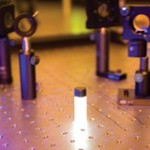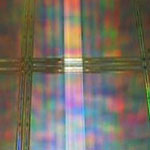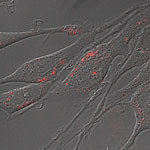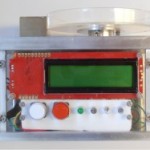Spinach power gets a major boost
Sep. 4, 2012—Spinach power has just gotten a big boost. An interdisciplinary team of researchers at Vanderbilt University have developed a way to combine the photosynthetic protein that converts light into electrochemical energy in spinach with silicon, the material used in solar cells, in a fashion that produces substantially more electrical current than has been reported by...
Richard Haglund named Stevenson Chair of Physics
Aug. 30, 2012—Twelve Vanderbilt University faculty members were honored for extraordinary contributions to their respective fields during an Aug. 28 celebration of endowed chair holders at the Student Life Center. Jeff Balser, vice chancellor for health affairs and dean of the School of Medicine, noted during his opening remarks the incredible range of expertise represented by the...
New research at Vanderbilt could help make quantum dots the future of superefficient lighting
Aug. 16, 2012—Unless you’re in the .05 percent of the population who enjoyed physics in high school, the term “quantum” probably calls to mind James Bond or Scott Bakula. But researchers at Vanderbilt University are working on a project that could bring the word into the everyday vernacular, and perhaps even have a hand in saving the...
Radiation damage bigger problem in microelectronics than previously thought
Jul. 19, 2012—The amount of damage that radiation causes in electronic materials may be at least 10 times greater than previously thought. That is the surprising result of a new characterization method that uses a combination of lasers and acoustic waves to provide scientists with a capability tantamount to X-ray vision: It allows them to peer through...
Probing the roots of depression by tracking serotonin regulation at a new level
Jun. 27, 2012—In a process akin to belling an infinitesimal cat, scientists have managed to tag a protein that regulates the neurotransmitter serotonin with tiny fluorescent beads, allowing them to track the movements of single molecules for the first time. The capability, which took nearly a decade to achieve, makes it possible to study the dynamics of...
Bridging the Gap in the Sciences – featuring VINSE IMS graduate students
Jun. 8, 2012—Vanderbilt is on track this year to become the number one producer of minority Ph.D. recipients in physics, astronomy and materials science, an area where minorities are grossly underrepresented. Watch the emotional journey of the latest doctoral graduates from the Fisk-Vanderbilt-Master’s-to-Ph.D. Bridge Program. https://news.vanderbilt.edu/2012/06/08/vucast-extra-bridge-program/
High school students turn blackberries into solar cells
May. 21, 2012—How can you squeeze electricity from a blackberry? A number of local high school students can answer this question from personal experience. They have actually made solar cells out of blackberry juice and measured the electrical power that they produce as part of an educational outreach program started this year by the Vanderbilt Institute of Nanoscale...
Steigerwald headed to Capitol Hill as congressional fellow
May. 18, 2012—Andrew Steigerwald is trading a Vanderbilt physics laboratory for the halls of Congress. The post-doctoral researcher has been selected by the Materials Research Society (MRS) and the Minerals, Metals and Materials Society (TMS) as their 2012-2013 Congressional Science and Engineering Fellow. Starting in September he will spend a year working as a special legislative assistant on the staff of a...
‘Extractionator’ could bring cheap and effective malaria diagnostics to millions
May. 9, 2012—Last December a trio of Vanderbilt researchers — Rick Haselton, professor of biomedical engineering, David Wright, associate professor of chemistry, and Ray Mernaugh, associate professor of biochemistry — snagged a $1 million grant from the Bill & Melinda Gates Foundation to develop a “low tech, high science” method for collecting and preparing the patient samples...
Quantum dots brighten the future of lighting
May. 8, 2012—With the age of the incandescent light bulb fading rapidly, the holy grail of the lighting industry is to develop a highly efficient form of solid-state lighting that produces high quality white light. One of the few alternative technologies that produce pure white light is white-light quantum dots. These are ultra-small fluorescent beads of cadmium...









